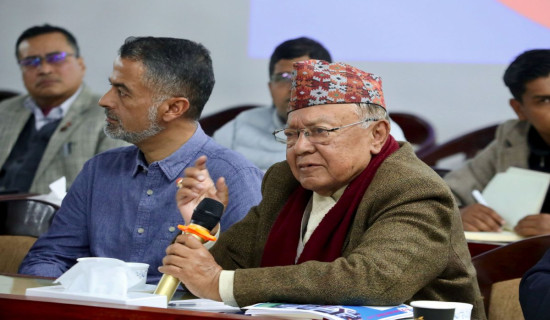- Tuesday, 23 December 2025
Promoting Ayurveda
Nepal is endowed with a diverse range of flora, and its distinct geographical characteristics and climate have made it a hub for several plant species, including medicinal herbs. The use of indigenous and medicinal plants in Ayurveda medicine and natural illness treatment has been carried out in the nation for generations. It is founded on the idea that health and wellness are dependent on a delicate balance of the mind, body, and spirit. Ayurvedic practitioners encourage healing and illness prevention by combining indigenous herbs, minerals, and other natural elements. One of the primary advantages of Ayurvedic treatment is that it provides a comprehensive approach to healing. Rather than addressing illness symptoms, Ayurveda seeks to address the underlying causes of the problem. This method is frequently more successful in the long run since it improves general health and wellness.
Nepal can boast of Singha Durbar Vaidhyakhana, a significant health centre where people were treated using Ayurveda medicines. For treating patients, it procures and processes herbs. Considering the historical significance of the Ayurveda method of treating illnesses, Prime Minister Pushpa Kamal Dahal Prachanda has pledged to promote Singha Durbar Vaidhyakhana as a national pride project. The Prime Minister told the 7th International Ayurveda Conference, which drew over 500 Ayurveda professionals, researchers, businessmen, physicians, students, teachers, producers, and businesses from over 50 countries, that the 300-year-old institute will be revitalised and improved as part of the national pride project. Since Ayurvedic medicines have become an important aspect of treating various ailments through a holistic healthcare approach, they should be promoted in Nepal that is rich in indigenous herbs and medicinal plants such as Yarshagumba, gooseberry, Rudraksha, Aswagandha, Brahmi, Satabari, Neem, Gurjo, Turmeric, and others.
According to reports, several industries in India and China have been importing Nepali herbs and earning a fortune by using them to make medications to cure various maladies. Nepal still lacks a sophisticated industry that processes these herbs and turns them into useful medications. As a result, enterprises like the Vaidhyakhana and others must be supported at the government level, and policy measures must be implemented to systematise medicinal plant imports and exports. It is encouraging that the government has mulled to set up a national Ayurveda research and training centre that will expand research on indigenous herbs and collect and process herbs in each province, where, according to the PM, about 100-bed Ayurveda hospitals will be built, while also promising some policy decisions to remove obstacles in the imports and exports of most essential medicinal herbs to facilitate the manufacturing of Ayurvedic medicines.
The potential for Nepal to become a major hub for medicinal plants, Ayurveda medicines, and natural healthcare systems is immense. A favourable climate should be developed for growth, process and export of these plants for which the sector should avail of the government assistance. With the Prime Minister's commitment to support the industry, it is possible that this ambitious goal can be achieved. Indigenous and other plants hold tremendous therapeutic capabilities that when used correctly can bring substantial health benefits not only through local consumption but also through increased export potential. With persistently increasing demand for natural alternatives for treating diseases, Nepal has an incredible opportunity to take advantage of its rich flora and create products that have both therapeutic value and economic benefit.

















